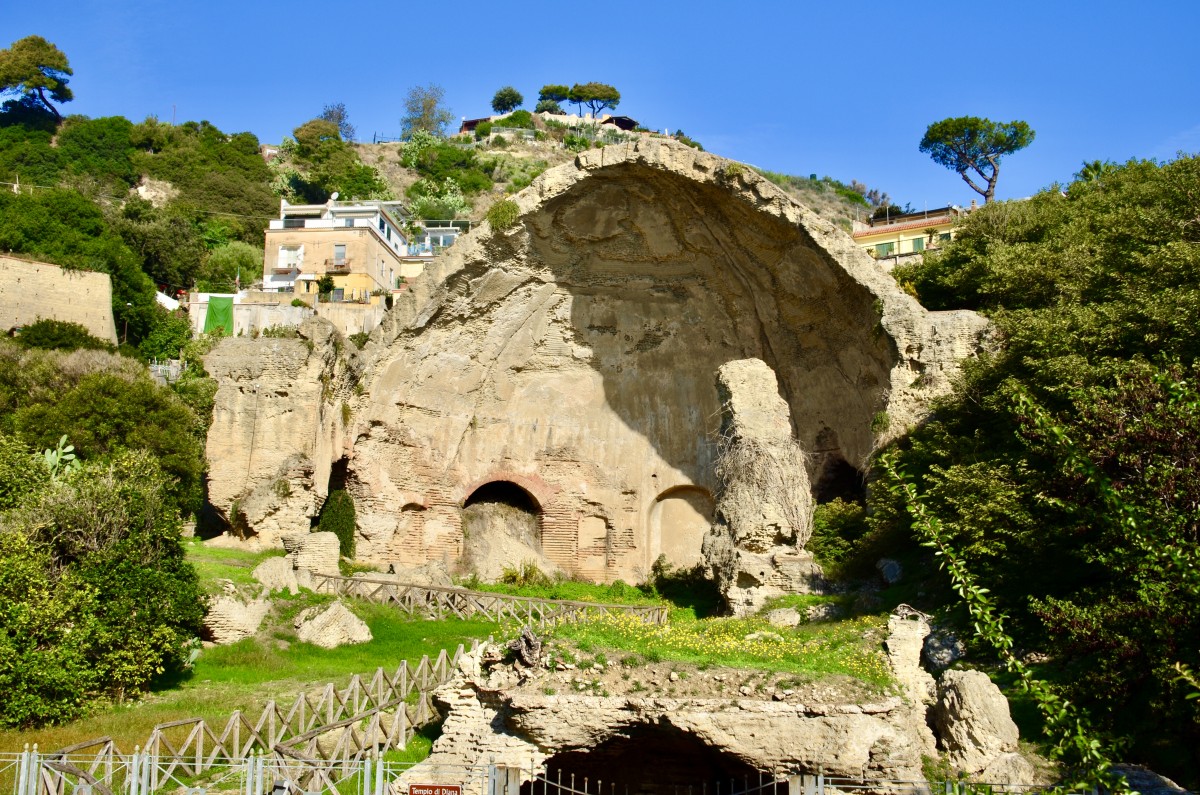North of Naples
(Archeological sites around of Naples)
22 Oct – We dedicated the last few days satisfying our Roman ruins cravings at various archeological sites around Naples. The other day when walking through town on the way to the castle, we walked along the Marina side and not through the Baia’s main street. As a result, we missed one of the most stunning ancient archeological sites around this part of the country. Nestled in the hills, right behind the semi-modern homes, rest an old Villa that used to extend out into the sea where the current town of Baia lies.
Terme Romane di Baia
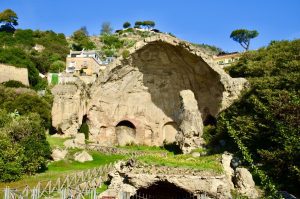
Local history has it that over time the villa morphed into a palace and then devolved into a hotel and finally a Thermal Hot Spring Resort. It’s current evolution is and interesting and intriguing collections of ruins. It’s an absorbing architectural wonder, with the Temple of Diana, the Temple of Mercurio, and the walls and foundations of the villa, palace and hot baths.
If you’re into architecture, and I kinda am, it’s fascinating to see how they built the ancient structures and layered more and more modern layers as the years wore on. Of particular interest is the strength of their cement! It’s a strange observation, but the effect of a cement that is more durable than the volcanic rock that it adheres to, is very artistic. The binding cement has retained its shape while time has eroded the volcanic bricks. The effect is a dimple of stone, surrounded by protruding cement boxes. In ‘olden days,’ those walls would have been covered by plaster or stucco and painted with images. But as decrepitude set in, the plaster fell away, and the exposed bricks slowly melted with time.
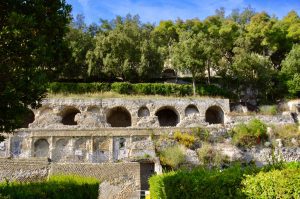
As the ruins stand now, it’s a confusing mix of home, vacation resort hotel, and thermal bath something or other. But, in its heyday in any of its incarnations, the site, overlooking the Mediterranean ocean with the ‘Little Rome’ town of Pozzuoli across the bay, must have been stunning. In a few spots, remain the tiled mosaics floors and walls. In a few, scarce places, one can see original faded paint on the walls. The palace must have been a kaleidoscope of colors and shapes, all intermingled with marble facia, statues, and fauna.
Temple of Mercurio
Two hours into wandering in the hot sun caused us to look towards moving out to our next site – Cuma. But, before leaving, we wandered into the Temple of Mercurio. It’s a vast domed structure with a central, ocular window at its apex and a few square ones scattered around its sides. The inside of the dome has a small island, surrounded by bright, cold waters. Inside the dome, one hears the most fantastical of echoes. A whisper in any corner (if the dome had corners) could be audible at a normal volume everywhere else. We couldn’t quite figure out what the place was intended for, worship, bathing, both? But, it was a wonder to visit.
Archeology of Cuma
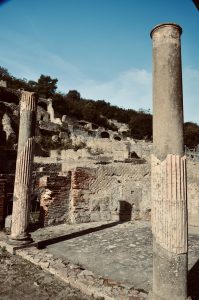
Off to our next spot, the archeological site of Cuma. Cuma is renown for its Greek Temple of Jove and Oracle of Sibila, where the faithful’s prophecies were uttered a millennium ago. Local history has it that this site was a principal Greek marina village, nestled on the coast and into the hills behind the bluff. On the highest spot rises both the Temple and Oracle, each with a commanding view of the ocean, beach, and surrounding lands. It’s quite a walk to get to the top, even with the steps carved out of stone and the ancient paved roads and walkways.
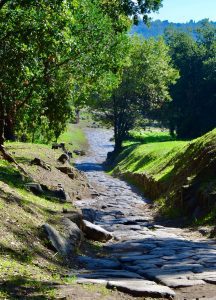 What remains fascinates the mind to what it was at its height. But again, there are lots of stones cast about, a few broken columns, whether they be Corinthian, Doric or Ionic, only the adept architecture or history devote can tell you. But, as these left behind elements crawl from the earth and stand upon the mound, they’re a testament to ages beyond that stood the time and ravages of war, pestilence, opulence, and finally depredations and abandonment. In the fields below are the reawakening ruins of a forgone city that is just now being uncovered by the government and teams of archeologist. Who knows what ancient secrets lie there to be discovered.
What remains fascinates the mind to what it was at its height. But again, there are lots of stones cast about, a few broken columns, whether they be Corinthian, Doric or Ionic, only the adept architecture or history devote can tell you. But, as these left behind elements crawl from the earth and stand upon the mound, they’re a testament to ages beyond that stood the time and ravages of war, pestilence, opulence, and finally depredations and abandonment. In the fields below are the reawakening ruins of a forgone city that is just now being uncovered by the government and teams of archeologist. Who knows what ancient secrets lie there to be discovered.
Amazingly friendly Italians
On the way over from the last site in Baia, we thought we’d walk to Cuma. Along the wa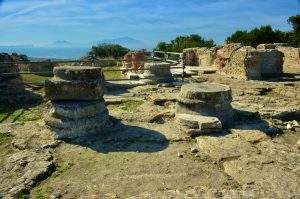 y, Ursula asked a gentleman walking our same direction if we were going the right way. He said, ‘follow me, I’ll show you the way.‘ What he meant was, ‘come with me and I’ll drive you there!’ We were gobsmacked. Everybody we have met in Italy has been kind, interested and generous with their time and assistance. This blew us away. In the end, we were grateful as he let us off in the center of the road during a busy traffic day. It phased nobody that this car stopped all traffic, in both directions, to let off strangers into the countryside. We were also happy because the ‘3 kilometers away’ that we were told of from the previous site was actually more like seven.
y, Ursula asked a gentleman walking our same direction if we were going the right way. He said, ‘follow me, I’ll show you the way.‘ What he meant was, ‘come with me and I’ll drive you there!’ We were gobsmacked. Everybody we have met in Italy has been kind, interested and generous with their time and assistance. This blew us away. In the end, we were grateful as he let us off in the center of the road during a busy traffic day. It phased nobody that this car stopped all traffic, in both directions, to let off strangers into the countryside. We were also happy because the ‘3 kilometers away’ that we were told of from the previous site was actually more like seven.
On the way back, we waited on the bus, as any attempt to negotiate the roads by foot is a death wish! We made it back to Mellisa’s and out of the sun before our brains baked. Time for another nap.
Another Fortress
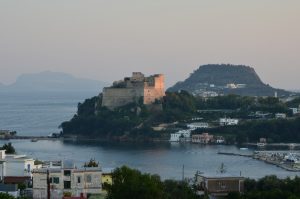
23 October, hot and sunny – Today’s excursion was back to the local Aragonese Fortress overlooking the ocean and bay. Our previous attempt to visit was blocked by its closure due to some archeological conference or other. The Fortress is enormous, it is domineering and massive. Apparently, the site started out as a temple, but when the Spaniards, presumably of Aragon, capture and ruled the area, they built the Fortress to house their soldiers. Legend has it that they didn’t use it for long as their protagonist at the time (French?) was defeated, and in time, the Fortress was converted to a military orphanage. In the last thirty years or so, it’s been evolved into a museum.
This museum houses a lot of the artifacts they’ve brought up from the surrounding bays. It’s populated with marble statues of every variety and condition. Each is a marvel to examine,,,, but after the first three dozen or so, to me, they all become one. So, the Fortress was fascinating, but worth a single visit.
Flavio Anfiteatro
Climbing down the steep roads from the Castle, Ursula ran out into the road to flag down a passing bus…and it stopped… and it let us on board. Just amazing! The driver confirmed that he was actually passing our next site, three towns, and a bay away. It was nice not to have to bear the sun’s burden to hike the seven miles to Italy’s third-largest amphitheater, the Flavio Anfiteatro in Pozzuoli. This site was just another incredible marvel, located in the heart of a functioning, thriving town.
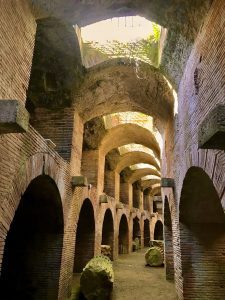
Back in the day (whatever age that may have been), some referred to Pozzuoli as the ‘little Rome’ as it was a central marina for all goods traveling between east and west. Today, it’s a bit more modest than that description, but the wonder of the ‘forum’ does attest to its past glory. Time has obviously ravaged the structure, but what remains, and much of it does, provides explorers with clear images of what it was before. The organized labyrinth of alleyways and rooms extending two floors below the stage above, is such that it’s easy to imagine them filled with lions and cheetahs and swearing and sweating gladiators. The stage above is elliptical and large, very large. Throughout the stage are numerous cavities where animals or other surprises and wonders could be lifted to the floor. The stadium itself holds thousands of viewers. What a site.
Flying Rats
So, as we wandered away from the ‘forum,’ we found a delicatessen shop to buy a sandwich and counter foods. We ended up back at the harbor’s park and sat in the shade as we fed ourselves and the eager flying rats…or pigeons. They knew how the game was played and swarmed us as soon as we threw down the first morsels of bread. But, it was a pleasant way to enjoy the local delicacies, in a serene park, next to a marina, in Italy. We made it home by train and ended another captivating day.
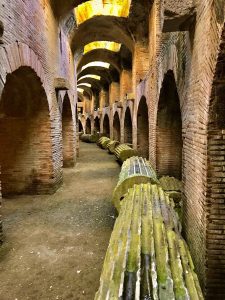
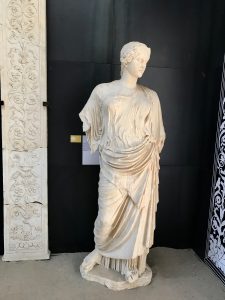
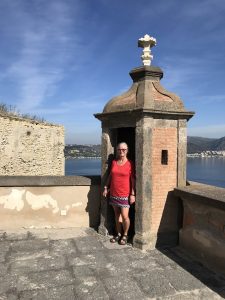
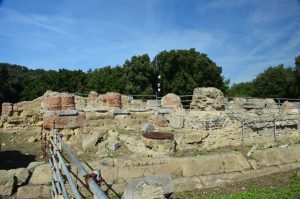
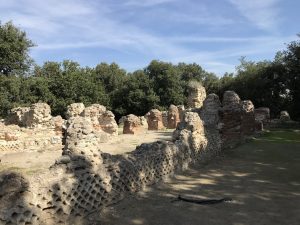
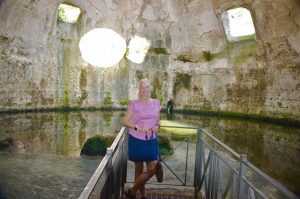
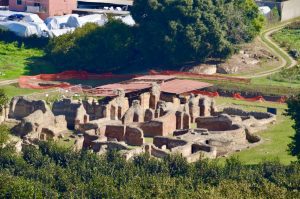
- Interested in the Touring Italy Blog?, this link will bring you to its beginning.
- See our ‘Best of Photos’ from the adventure here.
- Care to comment on the Blog or Adventure? Jot down your comments in the form below – thanks
